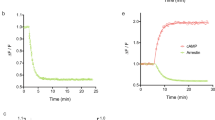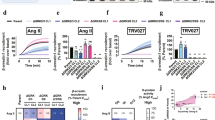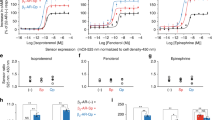Abstract
Functional selectivity of G protein–coupled receptor (GPCR) ligands toward different downstream signals has recently emerged as a general hallmark of this receptor class. However, pleiotropic and crosstalk signaling of GPCRs makes functional selectivity difficult to decode. To look from the initial active receptor point of view, we developed new, highly sensitive and direct bioluminescence resonance energy transfer–based G protein activation probes specific for all G protein isoforms, and we used them to evaluate the G protein–coupling activity of [1Sar4Ile8Ile]-angiotensin II (SII), previously described as an angiotensin II type 1 (AT1) receptor–biased agonist that is G protein independent but β-arrestin selective. By multiplexing assays sensing sequential signaling events, from receptor conformations to downstream signaling, we decoded SII as an agonist stabilizing a G protein–dependent AT1A receptor signaling module different from that of the physiological agonist angiotensin II, both in recombinant and primary cells. Thus, a biased agonist does not necessarily select effects from the physiological agonist but may instead stabilize and create a new distinct active pharmacological receptor entity.
This is a preview of subscription content, access via your institution
Access options
Subscribe to this journal
Receive 12 print issues and online access
$259.00 per year
only $21.58 per issue
Buy this article
- Purchase on Springer Link
- Instant access to full article PDF
Prices may be subject to local taxes which are calculated during checkout








Similar content being viewed by others
References
Kenakin, T. Agonist-receptor efficacy. II. Agonist trafficking of receptor signals. Trends Pharmacol. Sci. 16, 232–238 (1995).
Galandrin, S. & Bouvier, M. Distinct signaling profiles of β1 and β2 adrenergic receptor ligands toward adenylyl cyclase and mitogen-activated protein kinase reveals the pluridimensionality of efficacy. Mol. Pharmacol. 70, 1575–1584 (2006).
Urban, J.D. et al. Functional selectivity and classical concepts of quantitative pharmacology. J. Pharmacol. Exp. Ther. 320, 1–13 (2007).
Denis, C., Sauliere, A., Galandrin, S., Senard, J.M. & Gales, C. Probing heterotrimeric G protein activation: applications to biased ligands. Curr. Pharm. Des. 28, 128–144 (2012).
Ahn, S., Shenoy, S.K., Wei, H. & Lefkowitz, R.J. Differential kinetic and spatial patterns of β-arrestin and G protein–mediated ERK activation by the angiotensin II receptor. J. Biol. Chem. 279, 35518–35525 (2004).
Aplin, M. et al. The angiotensin type 1 receptor activates extracellular signal-regulated kinases 1 and 2 by G protein–dependent and –independent pathways in cardiac myocytes and Langendorff-perfused hearts. Basic Clin. Pharmacol. Toxicol. 100, 289–295 (2007).
Wei, H. et al. Independent β-arrestin 2 and G protein–mediated pathways for angiotensin II activation of extracellular signal-regulated kinases 1 and 2. Proc. Natl. Acad. Sci. USA 100, 10782–10787 (2003).
Galés, C. et al. Probing the activation-promoted structural rearrangements in preassembled receptor–G protein complexes. Nat. Struct. Mol. Biol. 13, 778–786 (2006).
Rasmussen, S.G. et al. Crystal structure of the β2 adrenergic receptor–Gs protein complex. Nature 477, 549–555 (2011).
Loening, A.M., Wu, A.M. & Gambhir, S.S. Red-shifted Renilla reniformis luciferase variants for imaging in living subjects. Nat. Methods 4, 641–643 (2007).
Pepperl, D.J. & Regan, J.W. Selective coupling of α2-adrenergic receptor subtypes to cyclic AMP-dependent reporter gene expression in transiently transfected JEG-3 cells. Mol. Pharmacol. 44, 802–809 (1993).
Daaka, Y., Luttrell, L.M. & Lefkowitz, R.J. Switching of the coupling of the β2-adrenergic receptor to different G proteins by protein kinase A. Nature 390, 88–91 (1997).
Offermanns, S. et al. Transfected muscarinic acetylcholine receptors selectively couple to Gi-type G proteins and Gq/11 . Mol. Pharmacol. 45, 890–898 (1994).
Nakahata, N. Thromboxane A2: physiology/pathophysiology, cellular signal transduction and pharmacology. Pharmacol. Ther. 118, 18–35 (2008).
Mervine, S.M., Yost, E.A., Sabo, J.L., Hynes, T.R. & Berlot, C.H. Analysis of G protein βγ dimer formation in live cells using multicolor bimolecular fluorescence complementation demonstrates preferences of β1 for particular γ subunits. Mol. Pharmacol. 70, 194–205 (2006).
Wong, S.K., Parker, E.M. & Ross, E.M. Chimeric muscarinic cholinergic: β-adrenergic receptors that activate Gs in response to muscarinic agonists. J. Biol. Chem. 265, 6219–6224 (1990).
Christensen, G.L. et al. Quantitative phosphoproteomics dissection of seven-transmembrane receptor signaling using full and biased agonists. Mol. Cell. Proteomics 9, 1540–1553 (2010).
Rajagopal, K. et al. β-arrestin 2–mediated inotropic effects of the angiotensin II type 1A receptor in isolated cardiac myocytes. Proc. Natl. Acad. Sci. USA 103, 16284–16289 (2006).
Hunyady, L. & Catt, K.J. Pleiotropic AT1 receptor signaling pathways mediating physiological and pathogenic actions of angiotensin II. Mol. Endocrinol. 20, 953–970 (2006).
Macrez-Leprêtre, N., Kalkbrenner, F., Morel, J.L., Schultz, G. & Mironneau, J. G protein heterotrimer Gα13β1γ3 couples the angiotensin AT1A receptor to increases in cytoplasmic Ca2+ in rat portal vein myocytes. J. Biol. Chem. 272, 10095–10102 (1997).
Hansen, J.L. et al. The human angiotensin AT1 receptor supports G protein–independent extracellular signal-regulated kinase 1/2 activation and cellular proliferation. Eur. J. Pharmacol. 590, 255–263 (2008).
Shukla, A.K. et al. Distinct conformational changes in β-arrestin report biased agonism at seven-transmembrane receptors. Proc. Natl. Acad. Sci. USA 105, 9988–9993 (2008).
Takasaki, J. et al. A novel Gαq/11-selective inhibitor. J. Biol. Chem. 279, 47438–47445 (2004).
Brini, M. et al. Transfected aequorin in the measurement of cytosolic Ca2+ concentration ([Ca2+]c). A critical evaluation. J. Biol. Chem. 270, 9896–9903 (1995).
Baukal, A.J., Hunyady, L., Catt, K.J. & Balla, T. Evidence for participation of calcineurin in potentiation of agonist-stimulated cyclic AMP formation by the calcium-mobilizing hormone, angiotensin II. J. Biol. Chem. 269, 24546–24549 (1994).
Ostrom, R.S. et al. Angiotensin II enhances adenylyl cyclase signaling via Ca2+/calmodulin. Gq-Gs crosstalk regulates collagen production in cardiac fibroblasts. J. Biol. Chem. 278, 24461–24468 (2003).
Audet, N. et al. Bioluminescence resonance energy transfer assays reveal ligand-specific conformational changes within preformed signaling complexes containing δ-opioid receptors and heterotrimeric G proteins. J. Biol. Chem. 283, 15078–15088 (2008).
Dupré, D.J. et al. Seven transmembrane receptor core signaling complexes are assembled prior to plasma membrane trafficking. J. Biol. Chem. 281, 34561–34573 (2006).
Kim, J., Ahn, S., Rajagopal, K. & Lefkowitz, R.J. Independent β-arrestin 2 and Gq/protein kinase Cζ pathways for ERK stimulated by angiotensin type 1A receptors in vascular smooth muscle cells converge on transactivation of the epidermal growth factor receptor. J. Biol. Chem. 284, 11953–11962 (2009).
Sun, Y. et al. Dosage-dependent switch from G protein–coupled to G protein–independent signaling by a GPCR. EMBO J. 26, 53–64 (2007).
Kohout, T.A., Lin, F.S., Perry, S.J., Conner, D.A. & Lefkowitz, R.J. β-arrestin 1 and 2 differentially regulate heptahelical receptor signaling and trafficking. Proc. Natl. Acad. Sci. USA 98, 1601–1606 (2001).
Whalen, E.J., Rajagopal, S. & Lefkowitz, R.J. Therapeutic potential of β-arrestin– and G protein–biased agonists. Trends Mol. Med. 17, 126–139 (2011).
Zhai, P. et al. Cardiac-specific overexpression of AT1 receptor mutant lacking Gαq/Gαi coupling causes hypertrophy and bradycardia in transgenic mice. J. Clin. Invest. 115, 3045–3056 (2005).
Christensen, G.L. et al. AT1 receptor Gαq protein-independent signalling transcriptionally activates only a few genes directly, but robustly potentiates gene regulation from the β2-adrenergic receptor. Mol. Cell Endocrinol. 331, 49–56 (2011).
Lefkowitz, R.J. & Whalen, E.J. β-arrestins: traffic cops of cell signaling. Curr. Opin. Cell Biol. 16, 162–168 (2004).
Kim, J. et al. Functional antagonism of different G protein–coupled receptor kinases for β-arrestin–mediated angiotensin II receptor signaling. Proc. Natl. Acad. Sci. USA 102, 1442–1447 (2005).
Breton, B., Lagace, M. & Bouvier, M. Combining resonance energy transfer methods reveals a complex between the α2A-adrenergic receptor, Gαi1β1γ2, and GRK2. FASEB J. 24, 4733–4743 (2010).
Zidar, D.A., Violin, J.D., Whalen, E.J. & Lefkowitz, R.J. Selective engagement of G protein–coupled receptor kinases (GRKs) encodes distinct functions of biased ligands. Proc. Natl. Acad. Sci. USA 106, 9649–9654 (2009).
Holloway, A.C. et al. Side-chain substitutions within angiotensin II reveal different requirements for signaling, internalization, and phosphorylation of type 1A angiotensin receptors. Mol. Pharmacol. 61, 768–777 (2002).
Hoffmann, C., Zurn, A., Bunemann, M. & Lohse, M.J. Conformational changes in G protein–coupled receptors—the quest for functionally selective conformations is open. Br. J. Pharmacol. 153 (suppl. 1), S358–S366 (2008).
Reiner, S., Ambrosio, M., Hoffmann, C. & Lohse, M.J. Differential signaling of the endogenous agonists at the β2-adrenergic receptor. J. Biol. Chem. 285, 36188–36198 (2010).
Reversi, A. et al. The oxytocin receptor antagonist atosiban inhibits cell growth via a “biased agonist” mechanism. J. Biol. Chem. 280, 16311–16318 (2005).
Burgen, A.S. Conformational changes and drug action. Fed. Proc. 40, 2723–2728 (1981).
Vaidehi, N. & Kenakin, T. The role of conformational ensembles of seven-transmembrane receptors in functional selectivity. Curr. Opin. Pharmacol. 10, 775–781 (2010).
Violin, J.D. et al. Selectively engaging β-arrestins at the angiotensin II type 1 receptor reduces blood pressure and increases cardiac performance. J. Pharmacol. Exp. Ther. 335, 572–579 (2010).
Violin, J.D. et al. Selectively engaging β-arrestins at the angiotensin II type 1 receptor reduces blood pressure and increases cardiac performance. J. Pharmacol. Exp. Ther. 335, 572–579 (2010).
Kenakin, T. Functional selectivity and biased receptor signaling. J. Pharmacol. Exp. Ther. 336, 296–302 (2011).
Leifert, W.R., Aloia, A.L., Bucco, O., Glatz, R.V. & McMurchie, E.J. G protein–coupled receptors in drug discovery: nanosizing using cell-free technologies and molecular biology approaches. J. Biomol. Screen. 10, 765–779 (2005).
Violin, J.D. & Lefkowitz, R.J. β-arrestin–biased ligands at seven-transmembrane receptors. Trends Pharmacol. Sci. 28, 416–422 (2007).
Blanpain, C. et al. CCR5 binds multiple CC-chemokines: MCP-3 acts as a natural antagonist. Blood 94, 1899–1905 (1999).
Acknowledgements
This paper is dedicated to the memory of Dr. Hervé Paris, who passed away suddenly during the process of this work. We thank T. Hébert, J. Javitch and M. Lohse for their critical reading of the manuscript and R. D'Angelo for excellent technical support and advice regarding imaging (Cellular Imaging Facility I2MC, TRI Platform). Wild-type, β-arrestin 1 knockout, and β-arrestin 1 and 2 double-knockout MEF cells were generously provided by R. Lefkowitz (Duke University Medical Center). This work was supported by a grant from the French National Research Agency (ANR-06-BLAN-0400-02 to C.G.) J.L.H. is sponsored by the Danish National Research Foundation, the Danish Council for Independent Research Medical Sciences and the Novo Nordisk Foundation.
Author information
Authors and Affiliations
Contributions
A.S. did most of the experiments, analyzed and interpreted data and cowrote the manuscript. M.B. did and interpreted all of the ERK experiments. H.P. helped construct and characterize the G protein BRET probes. C.D. did and analyzed the aequorin-based Ca2+ measurements in HEK293T cells. F.F. constructed and characterized the BRET-based PKA biosensor. M.-F.A. helped construct the G protein probes and M.-H.S. helped with cardiac-fibroblast primary cell culture. J.L.H. and J.T.H. provided the YM-254890 Gq inhibitor and several AT1-R–encoding plasmid vectors, and they helped with data interpretation and manuscript preparation. A.P. and J.-M.S. assisted with data processing and analysis and with manuscript preparation. C.G. designed and managed the overall project, analyzed and interpreted data and cowrote the manuscript.
Corresponding author
Ethics declarations
Competing interests
The authors declare no competing financial interests.
Supplementary information
Supplementary Text and Figures
Supplementary Methods and Supplementary Results (PDF 504 kb)
Rights and permissions
About this article
Cite this article
Saulière, A., Bellot, M., Paris, H. et al. Deciphering biased-agonism complexity reveals a new active AT1 receptor entity. Nat Chem Biol 8, 622–630 (2012). https://doi.org/10.1038/nchembio.961
Received:
Accepted:
Published:
Issue Date:
DOI: https://doi.org/10.1038/nchembio.961
This article is cited by
-
Systematic assessment of chemokine ligand bias at the human chemokine receptor CXCR2 indicates G protein bias over β-arrestin recruitment and receptor internalization
Cell Communication and Signaling (2024)
-
Platelet P2Y1 receptor exhibits constitutive G protein signaling and β-arrestin 2 recruitment
BMC Biology (2023)
-
PharmacoSTORM nanoscale pharmacology reveals cariprazine binding on Islands of Calleja granule cells
Nature Communications (2021)
-
TRUPATH, an open-source biosensor platform for interrogating the GPCR transducerome
Nature Chemical Biology (2020)
-
A kinetic method for measuring agonist efficacy and ligand bias using high resolution biosensors and a kinetic data analysis framework
Scientific Reports (2020)



